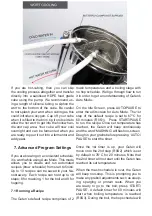
Once the grain has settled in, place the top
screen over the overflow pipe. The purpose
of the top screen is to evenly distribute the
flow of wort from the pump into the grain bed
during the mash and sparging. With the top
screen in place, turn on the pump and allow
the mash to recirculate gently for the rest of
the mash period. Recirculation is important
for maintaining an even temperature profile.
You can control the flow of the pump with the
valve under the Camlock fitting of the pump
return.
6.2 Steeping
Brewing specialty beers and dark beers will
require specialty grain steeping, which is
done at around 70°C for no longer than 20
minutes. Any hotter or longer will extract un-
wanted tannins from the specialty malt. The
right time to steep is typically after the mash
before lifting the malt pipe up.
6.3 Sparging
Sparging is an intermediate step between
the mash and the boil. It involves rinsing the
spent grain bed with water, no hotter than
70°C, to extract more sugars which in turn
adds more gravity points to the wort. It is
not compulsory for homebrewing, however
where mash efficiencies become relevant
for commercial brewers, it is still good prac-
tice to utilise the most out of your grains.
To sparge on the Guten, start by lifting up
the malt pipe and seating it above the brew
vessel.
Wait for the wort to fully drain out (known
as 1st runnings) before topping up the grain
bed with sparge water (2nd runnings). The
combined volume of both runnings will be
your preboil volume. For most 5 gallon
(19L) batches, a typical preboil volume is 7
gallons (26.5L).
Brewers can skip the sparge step altogether
and adjust their recipes to include for extra
grain to compensate. Preboil volumes in the
kettle can be achieved by simply adding wa-
ter to the wort before going into the boil.
Mash Paddle 0811
Sparging





























